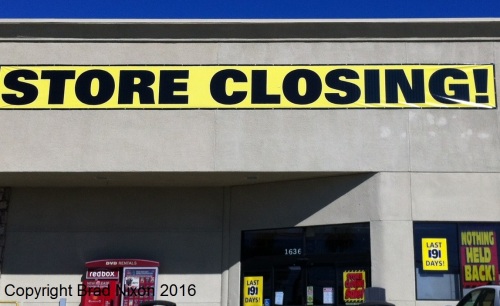One of a series of occasional posts about signs — sign posts.
It’s a fact; one of the few — if not the only — irrefutable, inevitable facts of the universe: All things must pass.
Energy and matter, stars and planets, states and nations, your favorite TV series, that little shop where you get absolutely the best coffee, traffic, even taxes: Nothing is exempt. The laws of thermodynamics are adamant. There is no court to which one can appeal the rather draconian nature of those laws.
Buddhists and anarchists are preparing, if not already set. The rest of us must shift as best we can.
The signs are everywhere.

Those signs, themselves, will go in time. For now, they mark the departure of a brick-and-mortar world being subsumed by a tidal wave of change. Video stores; electronics retailers; Mom-and-Pop hardware, grocery and general goods operations; bookstores: All are being swept away as online retailing, massive consolidation into mammoth mega-retailers and changes in consumer spending winnow the field.
There’s a story behind every sign.

Locally here in the South Bay of Los Angeles, the signs have been proliferating lately for a variety of reasons. The two signs shown above are on one of several score of locations that housed a new chain of grocery stores attempting to establish a large-scale presence in the crowded, highly competitive southern California market. They failed, utterly, after less than a year: a stupendously large blunder.
Other stories are more illustrative of the current retail landscape, rather than failures of business acumen.

A local specialty shop stocking a large inventory of cookware, kitchen equipment and gadgets, in business for more than 40 years, recently closed. The longtime owners attributed the decline in business to the competition from online sellers of identical goods at lower prices. According to an interview in the local newspaper, they saw an increasing amount of their in-store customers inspecting pans, dishes and coffee makers, comparing prices, then walking out to make their purchases elsewhere — presumably online.

Spanning the causes of poor business practices and intense competition is the nearly simultaneous bankruptcy of two large chains of sporting goods stores. They appear not to have been expertly managed regarding inventory and pricing, and to have failed to build their own online business models, losing on both ends.
The depths of the recession a few years ago prompted a wave of store closures, resulting in a surfeit of vacant (often very large) retail spaces. In 2010, I wrote 2 blog posts on the subject. One focused on some temporary, seasonal operations that were making use of vacant retail space in high traffic corridors: see “Horrorshow!”

In another, I came up with some imaginative new business concepts that might occupy the stores. See “When I Build My Megastore.”
Today, even the icons of retailing are beleaguered. Sears, J.C. Penny, Nordstrom and, as recently announced, Macy’s are struggling to sustain the all-in-one department store model. According to retail industry studies, a consumer trend is shifting away from buying extensive wardrobes or more home furnishings to spending on experiences like travel. Logically one could assume that the tax revenues and jobs lost as retailers close hundreds of locations might be replaced by concomitant gains in the travel and entertainment industries. But that irrevocable and universal Second Law of Thermodynamics tells us that entropy enters any system, spinning us down beyond some inescapable event horizon of lost energy and matter until, yes, everything must go.
What’s the retail picture in your town? What type of business will feel the bite next? Are you participating in the shadow economy of AirBnB, Uber; the robotically staffed empires of Amazon and Alibaba? Leave a comment.
© Brad Nixon 2016

“There’s a story behind every sign.”
I love this! It is so true. We live in a small town with a familiar story. WalMart moved in, small businesses and smaller competitors began to disappear. Second hand stores begin to appear, then disappear. There were indeed stories behind every liquidation story.
LikeLike
By: feistyfroggy on August 24, 2016
at 9:44 am
*liquidation sign.* (I really wish I knew how to edit comments! LOL
LikeLike
By: feistyfroggy on August 24, 2016
at 9:44 am
Another factor: the ever increasing concentration of wealth in the top 1% and depressed employee wages to keep it that way. In order to increase sales to the middle class with less money to spend, prices must also be depressed. To keep prices low and profits up, goods must be made overseas where wages are much lower than here. And that means a continuing loss of jobs here and business failures. Short term, the rich will continue to get richer. But this is ultimately a self defeating plan and this too will pass. As you rightly said, eventually everything must go.
LikeLike
By: La Boheme on August 24, 2016
at 12:40 pm